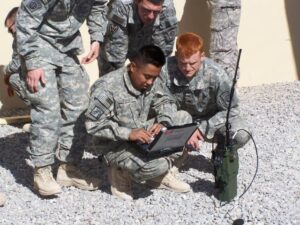Army Offers Much Higher Profits For Fast Innovation
Posted on

Bruce Jette addresses the AUSA Global Force conference in Huntsville.
AUSA GLOBAL FORCE SYMPOSIUM: If you have innovative technology to sell the Army, the service’s acquisition chief wants you to make more money — if you can deliver, fast. Speaking to the Association of the US Army conference this morning, Bruce Jette announced he’d secured
- new grants for innovative small businesses, which he started awarding at the conference; and
- new funding to help promising technologies cross the “valley of death” between lab work and adoption by a weapons program.
Looking forward, the Assistant Secretary of the Army for Acquisition, Logistics, & Technology — known as the ASA (ALT) — also proposed
- better protection for companies’ intellectual property; and
- higher profit margins for contractors that can deliver their products faster.
He also urged procurement officials to talk more with their counterparts in industry — a dialogue that’s been chilled by fears it could compromise competitions — and announced new rules on how Army-run laboratories should allocate their research funds.

A T2C2 inflatable antenna for satellite communications.
The Army Incubator
The most immediate source of money? “The Army Technology Incubator & Accelerator has been hearing pitches all week” at the AUSA conference, Jette said, and even awarding contracts to get particularly promising innovations quickly. A new initiative aimed at companies without much defense experience, he said, these are similar in size to Small Business Innovation Research (SBIR) Phase I contracts.
At this conference, Jette said, the incubator’s focus is on technologies relevant to command and control — i.e. the Army network — and precision navigation and timing — i.e. ways to locate yourself in space and time when an adversary jams GPS. At AUSA’s large annual conference in DC this October, he went on, the incubator will also be looking at Artificial Intelligence, Directed Energy (i.e. lasers and microwaves), materials science, and the Internet of Things. The incubator will also start using non-AUSA venues to find innovators, he said.

A soldier holds a PD-100 mini-drone during the PACMAN-I experiment in Hawaii.
The Valley of Death
The Pentagon has long struggled to get its weapons programs to adopt new technologies coming out of the laboratory. The labs, whose culture rewards breakthroughs, are enthusiastic about their innovations, but program managers, whose culture does not reward risk, often doubt that adding new tech to their weapons system will be worth the cost in money and time. Jette announced two initiatives to try to bridge this institutional and cultural divide.
First, “we are going to establish a fund specifically to cross the valley of death,” Jette said. If a program manager is considering adding a new technology but doesn’t have the budget for it, he or she can ask for additional money from the new fund. Then senior Army leaders will decide whether it’s worth the cost and potential delay.
“We’re going to have to be selective on those things we’re actually going to transition from research to programs… deliberately and with forethought,” he emphasized.
The Army is also working to “align” its Science & Technology (S&T) spending to its Big Six modernization priorities and existing programs. Under a new policy Jette is about to sign, each lab director must ensure 60 percent of basic and applied research (categories 6.1 and 6.2) must have “a relatively clear relationship” to some uniquely military purpose, he said. As research advances, the link has to get tighter: 80 percent of advanced technology and component development (6.3 and 6.4) must be endorsed by an existing program of record that’s interested in adopting it. Lab directors will still have freedom to allocate the remaining S&T funding (40 percent of 6.1 and 6.2, 20 percent of 6.3. and 6.4) at their discretion.

Army soldiers train with the PRC-117G radio in Afghanistan.
Intellectual Property
As software becomes increasing crucial to military capabilities from the F-35 stealth fighter down to handheld radios, intellectual property becomes increasingly vital to defense contractors. If your company’s competitive advantage is you stamp out sheet metal more efficiently, it’s probably hard for rivals to replicate your factory. If your advantage is superior software, however, it’s easy to copy your code.
“We’ve been sloppy — on both sides of the table — on how we manage our intellectual property,” Jette said.
Typically, when government and industry both contribute software to a military system, the two sets of code become intertangled, each interacting with and dependent on the other in myriad ways. Jette wants to move to what’s called an open architecture approach, in which each party contributes a self-contained module of software which interfaces with the other modules in a small number of clearly defined ways, according to some pre-established government or industry standard. As long as your module’s interface — its outer shell, as it were — meets the standard and connects to the rest of the system, no one needs to know the details of the code “inside” — where your IP resides.
When government does know a company’s IP, Jette added, officials need to be more scrupulous about protecting it. All too often, he said, when public documents like Requests For Information (RFIs) and Requests For Proposals (RFPs) lay out what the government wants, they’ll divulge key details of a competitor’s IP.

BAE’s Armed Robotic Combat Vehicle (ARCV), originally developed for the Future Combat Systems (FCS) program
Higher Profit Margins
“The Amy is the largest socialist organization defending capitalism on earth,” Jette said. Better performance doesn’t translate directly into pay raises, “money is not a big motivator,” and profit is often seen as “a dirty sinful thing that you guys want” — to be minimized as much as possible. (Though Jette didn’t say so, another persistent factor is Congress’s occasional eagerness to beat up “greedy” contractors).
As a result, the Defense Department tends to keep profits margins low, around 10 percent. Companies respond by dragging out programs as long as possible, because if they can’t get a bigger percentage, they can at least increase the total expenditure they get a percentage of.
But in the commercial world, Jette argues, many companies — especially the most innovative — are willing to pay a premium to get things done fast. If a company can deliver results in half the time, it’s probably worth letting them take twice as much percentage in profit.
“I want to start looking for contracts where we can do that,” Jette said.
The Army is urgently accelerating weapons programs from automatic rifles to robotic tanks. “I’m very open to looking at how we can improve your profits as long as you can improve my deliveries.”
Subscribe to our newsletter
Promotions, new products and sales. Directly to your inbox.
